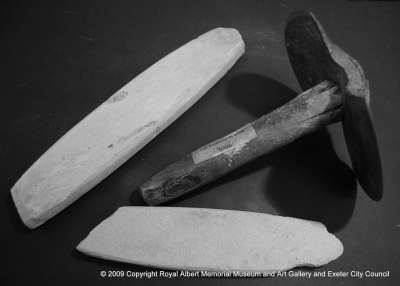Whetstone
In the 18th and 19th century a specialised tool-making industry grew in East Devon. Using local, very porous and abrasive sandstone, people started making sharpening tools, called whetstones or Devonshire 'Batts'. The whetstones were used for sharpening edged tools, like the blades of scythes and sickles.
Pieces of sandstone the size of a horse's head were obtained from horizontal shafts dug into the hillsides of the Blackdown Hills. They were then roughly shaped on the spot just outside the mines. People used a unique double-headed tool called a 'basing axe' to work the stone. The axes were made locally in Kentisbeare.
The stones were then brought down to the local villages to be hewn to their final dimensions of about 30 centimetres in length. Afterwards, women rubbed them down in hot water on a large stone of the same material. Shaping the stones was relatively easy since the rock was very moist and soft when it came out of the mines. Once tried, the whetstones became very hard and were fit for sale. They were taken to the ports of Topsham and Bridgewater to be shipped to London.
For 200 years the industry flourished, providing whetstones of a very high quality to a huge market. By 1900 there were only three mines left. By 1910 the invention of Carborundum stones spelt the end of whetstone mining. The last solitary miner left in 1929.
Pieces of sandstone the size of a horse's head were obtained from horizontal shafts dug into the hillsides of the Blackdown Hills. They were then roughly shaped on the spot just outside the mines. People used a unique double-headed tool called a 'basing axe' to work the stone. The axes were made locally in Kentisbeare.
The stones were then brought down to the local villages to be hewn to their final dimensions of about 30 centimetres in length. Afterwards, women rubbed them down in hot water on a large stone of the same material. Shaping the stones was relatively easy since the rock was very moist and soft when it came out of the mines. Once tried, the whetstones became very hard and were fit for sale. They were taken to the ports of Topsham and Bridgewater to be shipped to London.
For 200 years the industry flourished, providing whetstones of a very high quality to a huge market. By 1900 there were only three mines left. By 1910 the invention of Carborundum stones spelt the end of whetstone mining. The last solitary miner left in 1929.
Object Summary
- Accession Loan No.
- 11/1933/G230
- Collection Class
- Rocks
- Collection Area Region
- Northern Europe
- Common Name
- whetstone
- Simple Name
- rock: whetstone


